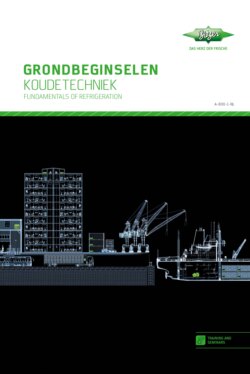Читать книгу GRONDBEGINSELEN KOUDETECHNIEK / In twee talen Nederlands/Engels - Volker Stamer - Страница 11
На сайте Литреса книга снята с продажи.
ОглавлениеTussen de roosterelementen is echter nog steeds
sprake van cohesiekrachten (hechtingskrachten). Deze
krachten worden bij de toevoer van meer warmte-ener-
gie overwonnen. De moleculen kunnen zich dan vrij in
damp- of gasvormige toestand in de ruimte bewegen.
Deze veranderingen in de fysische toestand kunnen
worden omgekeerd door warmte af te voeren.
De betreffende warmteafgifte resulteert in een speci-
fieke thermische toestand. Deze wordt bepaald door
een meetbare temperatuur. De temperatuur van alle
temperatuurafhankelijke fysische eigenschappen van
het lichaam (volume-uitzetting, elektrische weerstand,
enz.) is dus te meten.
De meeste thermometers zijn gebaseerd op de
thermische uitzetting van vloeistoffen, zoals kwik
en alcohol. Hiervoor moet een temperatuurschaal
worden gedefinieerd (zie fig. 2).
Aangezien specifieke fysische processen in de natuur
altijd plaatsvinden onder dezelfde omstandigheden en
bij dezelfde temperatuur, is het mogelijk om vaste tem-
peratuurpunten te definiëren. De bekendste daarvan
zijn het smeltpunt van ijs en het kookpunt van water.
Wanneer de uitzetting van een vloeistof tussen twee
vaste punten op een bepaalde manier wordt onder-
verdeeld, kunnen we een temperatuurschaal maken.
De Zweedse astronoom Anders Celsius (1701-1744)
stelde in 1742 een temperatuurschaal op, de zoge-
naamde Celsiusschaal. Hij gebruikte het kookpunt en
het vriespunt van water als ijkpunten. Daarbij koos hij
voor kwik als vloeistof en verdeelde de schaal in 100
gelijke subsecties. De grootte van een Celsiusgraad
was geboren. Door de Celsiusschaal gelijkmatig uit
te breiden tot boven het kookpunt en tot onder het
vriespunt, ontstond er een temperatuurschaal voor alle
temperatuurbereiken. Dergelijke temperatuurschalen
worden altijd willekeurig gedefinieerd.
De laagste temperatuur is -273,15°C. Deze waarde
wordt het absolute nulpunt genoemd. De thermody-
namische temperatuurschaal begint bij het absolute
nulpunt met 0 K (Kelvin, genoemd naar de Engelse
natuurkundige William Thomson, de latere Lord Kel-
vin, 1824-1907). Op grond van dit gegeven is er een
nieuwe basiswaarde voor de temperatuur ingevoerd,
de thermodynamische temperatuur.
Deze temperatuur van -273,15°C = 0 K kan nooit
worden bereikt omdat de warmte van een lichaam
alleen kan worden afgegeven aan een lichaam met
een nog lagere temperatuur.
still act among the lattice elements (adhesion forces).
These forces are overcome if the heat energy input
increases; the molecules can then move freely in
space in a vapour or gaseous state. These changes
in physical state can be reversed by removing heat.
The respective heat input results in a specific heat
status. This is determined by a measurable tempera-
ture. All temperature-dependent, physical properties
of the body (volumetric expansion, electrical resist-
ance, etc.) are suitable for temperature measure-
ments.
Most thermometers are based on the thermal expan-
sion of liquids such as mercury and alcohol. To achieve
this, it is necessary to define a temperature scale (see
Fig. 2).
Because specific physical processes in nature always
take place under the same conditions at the same
temperature, it is possible to define fixed temperatures.
Two of the best known are the melting point of ice and
the boiling point of water.
If the expansion of a liquid between two fixed points
is subdivided in a specific way, a temperature scale
can be designed. In 1742, the Swedish astronomer
Anders Celsius (1701–1744) defined such a tempera-
ture scale, known as the Celsius scale. He adopted
the boiling and freezing points of water as the fixed
points. He used mercury as the liquid and divided the
scale into 100 equal sections. This defined the size of
a Celsius degree. By uniformly extending the Celsius
scale above boiling point and below freezing point,
a temperature scale valid for all temperature ranges
can be achieved. These temperature scales are always
arbitrarily defined.
The lowest temperature possible is –273.15°C. This
value is referred to as the absolute zero point. The
thermodynamic temperature scale begins with abso-
lute zero at 0 K (Kelvin, named after the British phys-
icist William Thomson, later Lord Kelvin, 1824–1907).
On this basis, a new basic variable for temperature,
the thermodynamic temperature, is introduced.
This temperature of –273.15°C = 0 K can never be
achieved, because the heat that a body contains can
only ever be transferred to a body at an even lower
temperature.
Grondbeginselen thermodynamica // Fundamentals of thermodynamics
13
